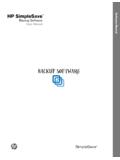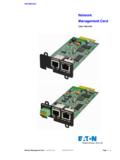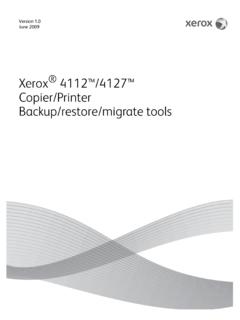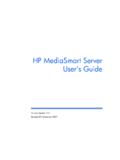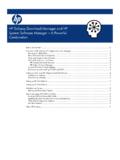Transcription of HandPunch
1 HandPunch 3000/4000. manual ATR Systems, Inc. Time & Labor Management Solutions Tel: Fax: P/N: 70100-6003 Version This equipment has been tested and found to comply with the limits for a Class B digital device, pursuant to part 15 of the FCC Rules. These limits are designed to provide reasonable protection against harmful interference when the equipment is operated in a commercial environment. This equipment generates, uses, and can radiate radio frequency energy, and, if not installed and used in accordance with the Installation manual , may cause harmful interference to radio communications. Operation of this equipment in a residential area is likely to cause harmful interference, in which case the user will be required to correct the interference at the user 's own expense. This Class A digital apparatus meets all requirements of the Canadian Interference-Causing Equipment Regulations.
2 Cet appareil numerique de la classe A respecte toutes les exigences du Reglemente sure le materiel brouilleur du Canada. 1998 through 2003 Recognition Systems, Inc. ALL RIGHTS RESERVED. Document Part Number: 70100-6003 Revision 3 July, 2003. HandPunch is a trademark of Recognition Systems, Inc. The trademarks used in this manual are the property of the trademark holders. The use of these trademarks in this manual should not be regarded as infringing upon or affecting the validity of any of these trademarks. Recognition Systems, Inc. reserves the right to change, without notice, product offerings or specifications. No part of this publication may be reproduced in any form without the express written permission from Recognition Systems, Inc. Table of Contents Introduction 3. Biometrics 4. Principle of Operation 4.
3 Specifications 7. Planning an Installation 11. Site Preparation 11. HandPunch Placement 11. Wiring 12. Power Input 12. Battery Backup 12. Earth Ground and Shielding 13. Communications 18. External Devices 20. Mechanical Installation 23. Wall Plate Installation 23. Mounting the Wall Plate 24. Networking and Communications 27. Stand-alone HandReader 27. Master or Remote HandReader in a HandReader Network 27. Remote HandReader in a HandReader Network Connected to a Host PC 27. Remote HandReader Connected to a Host PC via Optional Modem 28. Remote HandReader Connected to a Host PC via Optional Ethernet 29. Printer 29. Wiring Connections 31. Erasing the Memory 43. Closing the HandPunch 45. Enter Command Menu 47. If No One is Enrolled in the HandPunch 47. If Users are Enrolled in the HandPunch 47. Navigating Command Menus 49.
4 Programming the HandPunch 51. Service Menu 54. Setup Menu 56. Management Menu 60. Enrollment Menu 63. Special Menu 67. HandPunch Maintenance 69. Appendix A - Installation Tips 71. Appendix B - Differences in Board Layout 73. Appendix C Old Installation Guide 77. Appendix D - Troubleshooting 95. Glossary 97. Limited Warranty 99. HandPunch 3000/4000 manual Introduction The HandPunch 3000/4000 is part of Recognition Systems' 3rd generation line of biometric hand geometry Time and Attendance Terminals1. The HandPunch records and stores a three-dimensional shape of the human hand for comparison and identity verification. Upon verification, the HandPunch records the time, date, user ID number, and collected time and attendance data for collection by a host computer. The HandPunch can produce an output that can unlock a door and it can communicate with a host computer.
5 The HandPunch also has auxiliary inputs and outputs that can be used to control other systems such as bells and alarms. The HandPunch provides proof-positive employee verification combined with the sophisticated operating features one expects in a modern Time and Attendance Terminal. Because of this unique combination of capabilities, the HandPunch provides the most accurate Time and Attendance data collection terminal available. The key features of the HandPunch include: Programmable Function Keys - HP-3000 2. - HP-4000 10. user Time Restrictions Supervisor Override at the Time Clock . - Add Punch - Add Bulk Hours or Dollars - Review Punches Department Transfers Explicit Punch Menu Transaction Buffer - HP-3000 5,120 event capacity - HP-4000 7,680 event capacity Bell Schedules Door Control and Monitoring Programmable Clock and Date Formats and Daylight Savings Switch-over The HP-4000 also includes: Integrated Bar Code Reader Programmable user Messages Data Validation 1.
6 For the sake of using a consistent name throughout the manual , the HandPunch 3000/. 4000 terminal is referred to as the HandPunch for the remainder of this manual . Page 3. Introduction Biometrics Biometrics is a term describing the automatic measurement and comparison of human characteristics. While its origins are ancient, the evolution of advanced scanning and microprocessor technology brought biometrics into everyday life. Electronic hand geometry technology first appeared in the 1970s. Recognition Systems Inc., founded in 1986, built the first mass-produced hand geometry readers and made biometric technology affordable for the commercial market. Today, Recognition Systems' products are in use in every imaginable application from protecting cash vaults to verifying employee attendance in hospitals.
7 Principle of The HandPunch uses low-level infrared light, optics, and a CMOS camera to Operation capture a three-dimensional image of the hand. Using advanced microprocessor technology, the HandPunch converts the image to an electronic template. It stores the template in a database along with the user 's ID number. To gain punch, the user enters his or her ID number at the HandPunch 's keypad or uses an external card reader. The HandPunch prompts the user to place his or her hand on the HandPunch 's platen1. The HandPunch compares the hand on the platen with the stored user 's unique template. If the images match, the HandPunch records the transaction for processing. The The HandPunch is a time and attendance terminal designed for use with time HandPunch and attendance software. Refer to Figures 1-1 on page 5 and 1-2 on page 6 when Terminal reviewing the information in this section.
8 The HandPunch has an integrated keypad for ID entry and reader programming. The HandPunch 3000 has two function keys (F1 and F2 see Figure 1-1). The HandPunch 4000 has ten function keys (F1 through F10 see Figure 1-2). These function keys can be programmed to collect data or to activate auxiliary outputs. The CLEAR and ENTER keys assist in data entry and programming. 1. The Platen is the flat surface at the base of the HandPunch (see Figure 1-1). This is where users place their hands for enrollment and verification. It has guide pins to assist positioning the fingers during use. Page 4. HandPunch 3000/4000 manual Four different features assist the user with hand placement and read verification. 1. A light emitting diode (LED) hand placement display on the HandPunch 's top panel assists users with hand placement on the platen.
9 2. A liquid crystal display (LCD) shows operational data and programming menus. 3. Red light/Green light verification LEDs quickly inform users if their verifica- tion attempts were rejected or accepted. 4. An internal beeper provides audible feedback during keypad data entry and user verification. HAND. PLACEMENT. DISPLAY. VERIFICATION. LIGHTS. LCD DISPLAY. Recog nition System s Inc. NUMERICAL. KEYPAD 1. 2. 4 3. Clear 5. 7 6. F1. FUNCTION. 8. *. No 9. F2. 0. #. KEYS. Nos Ye Ente r PLATEN AND GUIDE PINS. Figure 1-1: The HandPunch 3000. Page 5. Introduction HAND. PLACEMENT. DISPLAY. VERIFICATION. LIGHTS. LCD DISPLAY. Recog nition System s Inc. NUMERICAL. KEYPAD 1. 2. 4 3. Clear 5. 7 6 F3. F1. 8 F7. No*. 9 F4. F2. 0. BAR CODE. F8. Nos Ye #. Ente F5. r F9. CARD. F6. F10. READER. FUNCTION. KEYS. PLATEN AND GUIDE PINS.
10 Figure 1-2: The HandPunch 4000. Page 6. HandPunch 3000/4000 manual Specifications Table 1: Specifications Size: inches wide by inches high by inches deep cm wide by cm high by cm deep Power: 12 to 24 VDC or 12 to 24 VAC 50-60 Hz, 7 watts Weight: 6 lbs ( kg) 7 lbs ( kg) with optional backup battery Wiring: 2 twisted-pair, shielded, AWG 22 or larger (such as Belden 82732). Temperature: -10 C to +60 C non-operating/storage (14 F to 140 F). 5 C to 40 C operating (40 F to 110 F). Relative Humidity Non- 5% to 95% non-operating/storage (non-condensing). Condensing: 20% to 80% operating Verification Time: 1 second or less Memory Retention: 5 years using a standard internal lithium battery Transaction Buffer: HP-3000 5,120 transactions HP-4000 7,680 transactions ID Number Length: 1 to 10 digits Baud Rate: 300 to K bps Communications: RS-232, RS-422, optional Modem, optional Ethernet user Capacity: HP-3000 512 users expandable to 40,xxx HP-4000 530 users expandable to 5,xxx Message Capacity: HP-4000 550 expandable to 3520 (not available with the HP-3000).


